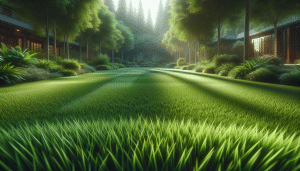Secrets to Low-Maintenance Gardens You’ll Love
Henry King October 15, 2025
Curious how some homeowners keep their gardens lush with minimal effort? Discover low-maintenance gardening tips, the best plants to choose, landscaping strategies, and little-known watering techniques to make home gardening rewarding and easy. Whether seeking sustainability or just a beautiful green retreat, this guide helps every step.
Why Low-Maintenance Gardens Appeal to Busy Lives
Today’s hectic schedules rarely allow for hours spent weeding, pruning, or mowing. Low-maintenance gardens have soared in popularity because homeowners crave the joy of greenery without daily toil. These easy-care landscapes can offer visual beauty, peace, and biodiversity. By designing with nature’s rhythms in mind, it’s possible to nurture an inviting oasis while spending less time and resources. Choosing the right features means each visit to the garden brings more pleasure than work. A thriving landscape is within reach—even if spare time is hard to find (Source: Better Homes & Gardens).
More people want eco-friendly yards that also save water, time, and energy. Selecting native plants and mulching well supports these goals. Such approaches also improve soil health over time. This approach means gardeners enjoy vibrant flowers and green leaves all season, with less need for chemical inputs. The result? Less worry about pests and failed blooms, and more enjoyment. Sustainable designs focus on the right plants and supporting smart growth. Simple changes deliver stress-free beauty.
Minimal effort doesn’t mean dull. Low-maintenance gardens look stunning with thoughtful plant selection, grouping, and layering. These principles foster resilience, thriving in many climates while resisting disease and drought. Relaxation is easier when we know our yards require just routine checks and an occasional gentle hand. For those balancing family, work, and personal time, a garden can truly become a haven rather than a project (Source: Penn State Extension).
Choosing Plants That Practically Care for Themselves
The cornerstone of a low-maintenance garden lies in choosing plants that suit local conditions naturally—especially drought-tolerant and pest-resistant species. Native perennials top the list, often coming back year after year with barely any fuss. Once established, they fend for themselves and encourage pollinators like bees and butterflies. Succulents and ornamental grasses are two choices that need little watering or pruning to shine. Mixing these varieties creates ongoing interest and reduces the pressure of weekly maintenance (Source: Royal Horticultural Society).
Integrating groundcovers such as creeping thyme, ajuga, or sedum blocks weeds and lowers mowing frequency, filling gaps in flowerbeds and along pathways. Shrubs like boxwood and hydrangea provide year-round structure and color. By grouping plants with similar sunlight and moisture needs, maintenance becomes far easier. Thoughtful placement lets nature assist, supplying shade, improving drainage, and sustaining healthy soil life—all conditions that help useful plants thrive without extra attention.
Annuals have their place, especially in containers or small areas for splashes of changing color. But the regular work of replanting can quickly add up. Sticking mainly to hearty perennials gives the most carefree results. For those curious about edibles, herbs such as rosemary and oregano thrive on neglect and offer both fragrance and flavor. Ultimately, investing in resilient varieties minimizes demanding tasks and creates a self-sustaining ecosystem just outside your door.
Designing Your Landscape for Effortless Care
Garden design can make or break how much care is needed. Begin with a simple layout, minimizing intricate curves or fussy features that demand upkeep. Wide curving beds edged with stone or brick add polished definition and prevent grass from encroaching. Layer taller plants at the back, mixing heights and textures to create depth. Fewer but fuller beds are easier to manage than many scattered small ones. Letting a garden evolve naturally, rather than tightly controlling every inch, leads to less pruning and weeding (Source: Clemson Cooperative Extension).
Avoid the temptation for expansive lawns—these require regular mowing and watering. Instead, use gravel paths, stone patios, or mulched walkways. They deliver structure without ongoing care and channel foot traffic away from vulnerable plantings. Raised beds are another clever trick: they offer easier access and better drainage. Select hardscaping materials that weather well and demand little: think stone, gravel, or composite decking over wood that needs constant staining.
Drainage matters too. Position plants in areas that match their needs: wet-loving varieties near downspouts or low spots, drought-tolerants in sunnier, well-drained sections. Sloping beds gently can direct water where it’s needed. Each thoughtful arrangement chosen for the yard’s conditions makes garden care less taxing and supports resilience in every season. The result is an inviting outdoor space that almost tends itself.
Smart Watering Techniques for Easy-Growing Gardens
Water management is critical for low-maintenance success. Efficient systems like drip irrigation, soaker hoses, and rain barrels save both time and money. These methods target moisture at the root zone, reducing evaporation and discouraging weeds by keeping other areas dry. Scheduling longer, infrequent waterings encourages deep roots, building drought resistance. A timer transforms regular chores into set-and-forget routines, making it simple to maintain healthy growth even if travel or weather interrupts.
Mulching provides another secret to low-maintenance gardening. A thick carpet of bark, straw, or leaf mold shields soil, holding in moisture and insulating roots. Paired with organic matter, it creates a rich environment that slowly nourishes plants through the seasons. Mulch also prevents weeds and reduces compaction, which means happier microbes and less manual labor from the gardener. Just remember the right mulch for each plant—some thrive with organic layers, others with stone or gravel for drainage.
Finally, consider rain gardens. These shallow, planted depressions capture and filter stormwater runoff. Rain gardens are both beautiful and sustainable, requiring less supplemental irrigation. They transform heavy rains into a resource for border plants and support pollinator habitats. Not only is water conservation important, but these systems also buffer yards against flooding and drought. Homeowners report fewer irrigation worries and more stable plant health over time. Learn more about water-wise solutions from respected gardening organizations (Source: The Xerces Society).
Reducing Weeds, Pests, and Other Garden Hassles
Few things frustrate gardeners more than stubborn weeds or relentless bugs. The best defense is planning: space plants close enough that their canopies shade the ground, leaving little room for intruders. Applying pre-emergent natural herbicides or using weed-blocking fabrics further tips the odds in your favor. Mulching, as mentioned, doubles as a weed deterrent and soil improver. Regular inspection is key; spotting problems early saves time later.
Pest management gets easier when gardens support their own balance. Welcoming beneficial insects, such as ladybugs and lacewings, reduces the need for intervention. Nematodes—tiny soil-dwellers—target root-eating pests naturally, sparing plants. Rotating crops from year to year and mixing plant families prevents disease buildup, keeping soil healthy and growth vigorous. Try adding marigolds around vegetables or roses; they ward off some nematodes and pests (Source: UC Integrated Pest Management).
Some effort up front pays off with easier gardening year after year. It’s worth researching your location’s most common garden issues so they can be tackled proactively. With a blend of mulch, close plantings, natural predators, and mixed species, gardens resist weeds and pests more effectively. This leaves more time to relax outside, enjoying the sights and scents rather than fighting unwelcome invaders.
Garden Tools, Mulches, and Supplies That Simplify Everything
The right tools turn maintenance chores from daunting to doable. Ergonomic, lightweight hand tools limit strain and make quick work of grooming. Quality gloves, sturdy pruners, and a multi-use cultivator mean less time spent searching for gear and more focused effort. Small carts for moving mulch or compost also spare backs and save trips. Investing in durable garden gear pays off over the years with fewer replacements and repairs (Source: Gardening Know How).
Mulch is a gardener’s best friend for easy care. Organic types—like bark, shredded leaves, or compost—suppress weeds and enrich soil as they decompose. In dry climates, gravel or stone mulch reflects the sun and trims water loss. Laying a fresh layer each spring or fall sets the garden on a path for months without extra weeding or watering. Mulch collars around trees and shrubs streamline mowing, too, making tasks fast and tidy.
Supplies such as soaker hoses, compost bins, and raised bed kits all contribute to less labor-intensive gardening. These items reduce the need for constant intervention—so lawns and flowerbeds remain lush and productive with far less manual input. Savvy gardeners know that small, smart investments up front deliver lasting rewards, providing seasons of abundant growth and lower stress. Explore local gardening extensions for supply recommendations tailored to your local soil and climate.
References
1. Better Homes & Gardens. (n.d.). Low-maintenance gardening tips. Retrieved from https://www.bhg.com/gardening/yard/garden-care/low-maintenance-gardening-tips/
2. Penn State Extension. (n.d.). Low-maintenance landscaping. Retrieved from https://extension.psu.edu/low-maintenance-landscaping
3. Royal Horticultural Society. (n.d.). Low maintenance plants. Retrieved from https://www.rhs.org.uk/garden-inspiration/advice/low-maintenance-plants
4. Clemson Cooperative Extension. (n.d.). Low-maintenance landscape ideas. Retrieved from https://hgic.clemson.edu/factsheet/low-maintenance-landscape-ideas/
5. The Xerces Society. (n.d.). Managing rain gardens for pollinators. Retrieved from https://xerces.org/rain-gardens
6. UC Integrated Pest Management. (n.d.). What is IPM? Retrieved from https://ipm.ucanr.edu/GENERAL/whatisipm.html







